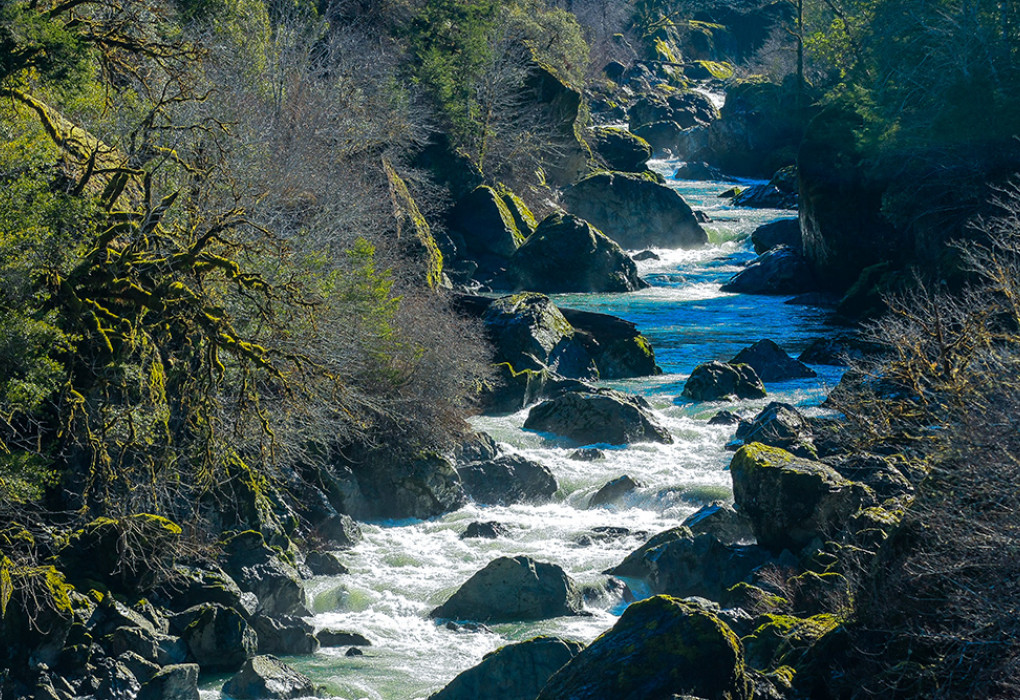Congressman Uses Falsehoods to Urge Reopening Kalmiopsis and Wild Rivers Coast for Strip Mining
For immediate release
Contacts:
Dave Lacey, Hunter Creek River Steward & Oregon South Coast Tours, 541-373-0487, dave@southcoasttours.net
Susan Jane Brown, Western Environmental Law Center, 503-914-1323, brown@westernlaw.org
Joseph Vaile, Klamath-Siskiyou Wildlands Center, 541-488-5789, joseph@kswild.org
David Moryc, American Rivers, 503-307-1137, dmoryc@americanrivers.org
Mark Sherwood, Native Fish Society, 303-898-8988, mark@nativefishsociety.org
Residents Vow to Fight Attacks on Clean Water and Salmon
Gold Beach, OR – Businesses, elected officials, and river conservation groups are speaking out against renewed threats to some of the most productive salmon streams in the Pacific Northwest and an important drinking water source and recreation asset for local communities.
Chairman of the House Committee on Natural Resources Rob Bishop last week asked the Trump administration to initiate a process that could reverse existing federal protections for portions of the Illinois, Rogue and Smith River watersheds and Hunter Creek in Southwest Oregon despite overwhelming local and bipartisan support. In a letter filled with inaccuracies, the representative from Utah called on the Trump administration to review all mineral withdrawals—temporary bans on new mining claims—adopted over the past eight years.
Rep. Peter DeFazio, who represents the Oregon lands in question, responded with his own statement panning the effort to reopen this area for strip mining.
"This is an egregious overstep by Washington, driven by special interests," DeFazio said. "Reopening this area to allow a foreign company to strip mine our public lands without paying American taxpayers hardly any royalties would devastate surrounding economies and threaten critical drinking water sources."
At issue is a 20-year mining ban for over 101,000 acres of public lands managed by Rogue River-Siskiyou National Forest and the Bureau of Land Management adopted after a multi-year public process that concluded with 45,000 comments—99 percent of which were in favor of protecting the area. The withdrawal area is home to ecosystems with plants found nowhere else on the planet and crystal clear wild rivers that teem with native salmon and provide clean drinking water for tens of thousands of Oregonians and Californians.
"Protecting this area is the right thing to do for our clean drinking water and California," said California State Sen. Mike McGuire. "As reflected by the Smith River Watershed Protection Resolution passed by our Assembly and Senate, our public trust agencies, our citizens, and all of the relevant government and public service entities downstream from the proposed nickel strip mining—and this includes the Crescent City-Del Norte County Chamber of Commerce representing 350+ businesses—the state of California overwhelmingly supports the 20-year mining ban."
"Our community has worked very hard over the last few years to develop our outdoor recreation economy. Strip mining flies in the very face of all ours efforts! Strip mines are as out of place on the stunning Wild Rivers Coast as a mustache on a baby! This special corner of Oregon deserves to be protected from the most polluting industry in the world, and all of us locals want to see the mineral withdrawal stay in place," said Dave Lacey, owner of South Coast Tours in Gold Beach, Oregon.
These nationally significant natural areas include Rough and Ready Creek (headwaters of the National Wild and Scenic Illinois and Rogue Rivers), Baldface Creek (headwaters of the Wild and Scenic Smith River and Redwood National Park), plus Hunter Creek and the Pistol River—all watersheds of immense beauty that power a strong economic engine for the surrounding rural communities, which depend on sport and commercial fishing, recreation, and tourism industries.
"People come here from all over the country to fish for salmon," said Harvey Young with FISHAWK River Company based in Brookings, Oregon. "The economic value of the sustainable fishery for the local economy far outweighs the short term profits of some foreign mining company that would wreck our clean drinking water and wild rivers forever. Guiding is how I support my family—fish are money—and fishing supports lots of other local businesses, too."
Broad and diverse local and regional constituencies strongly support the protection of these southwest Oregon lands from mining, including bipartisan support from local city councils, Tribal leaders, county commissions, business leaders, and other community organizations. Oregon’s two senators and the region's U.S. House representatives supported the effort by introducing legislation to protect the area.
"These rivers are national treasures. The communities have spoken out and there is bipartisan support for saving these rivers. This is no place for a strip mine," said Joseph Vaile of the Klamath-Siskiyou Wildlands Center, based in southwest Oregon.
"Rep. Bishop’s letter is just about as ‘fact-challenged’ as it gets," said Susan Jane Brown, staff attorney for the Western Environmental Law Center. "Just like Sec. Zinke’s ill-informed attack on national monuments, now we have members of congress making up their own version of reality in an effort to curry favor with extractionists who want to destroy some of the most pristine salmon streams in Oregon. The truth is that we fought to protect Rough and Ready, Baldface, Hunter Creek, and the Pistol in the first instance, and we will continue to fight for their permanent protection."
"Wild salmon still return to the rivers of southwest Oregon in remarkable abundance. Once threatened by a foreign-owned strip mining company, the Rogue River and its tributary the Illinois will see 200,000 wild king salmon this year," said Mark Sherwood of the Native Fish Society, who lives in Brookings. "These fish nourish local communities, support their economies, and feed one of the most ecologically diverse regions on the west coast. To reopen the possibility of mining runs counter to the overwhelming local public support and would jeopardize one of the last great bastions for wild salmon in the Northwest."
###
The same broad coalition that fought for and secured the southwest Oregon mineral withdrawal has pointed out at least six inaccuracies in Rep. Bishop’s letter to the secretaries:
FALLACY #1: Bishop characterizes the withdrawal as "illegal," suggesting that the Federal Lands Policy Management Act (FLPMA) prohibits withdrawals over 5,000 acres.
- Under FLPMA, the term "withdrawal" is defined as: "...withholding an area of Federal land from settlement, sale, location, or entry, under some or all of the general land laws, for the purpose of limiting activities under those laws in order to maintain other public values in the area."
FALLACY #2: Bishop characterizes the southwest Oregon mineral withdrawal as "baseless" and rooted in "false premises of environmental protectionism"
- TRUTH: The southwest Oregon mineral withdrawal protects four National Wild and Scenic Rivers, including the headwaters of Redwood National Park—landscapes with clear national significance. The Wild and Scenic rivers provide clean drinking water for communities; outstanding recreation opportunities, and world-class salmon and steelhead runs that support recreational and commercial fisheries and local tourism based economies. These critical values would be put at high risk by strip mining at headwaters in a region with extremely high precipitation.
According to U.S. EPA, metal mining is the nation’s most polluting industry.
FALLACY #3: Bishop suggests that there was no withdrawal legislation in play at the start of the 115th Congress when the southwestern Oregon mineral withdrawal went into effect.
- TRUTH: The effective date of the Public Land Order for the southwestern Oregon mineral withdrawal was Dec. 30, 2016, before the end of the 114th Congress. The withdrawal was tiered to the Southwestern Oregon Watershed and Salmon Protection Act of 2015 (H.R. 682/S. 346), introduced on Feb. 3, 2015. The Southwest Oregon Watershed and Salmon Protection Act was reintroduced into the 115th Congress by Reps. DeFazio and Huffman as H.R. 310 on Jan. 5, 2017 and by Oregon Sens. Wyden and Merkley as S. 192, on Jan. 23, 2017, when it was read twice and referred to the Senate Committee on Energy and Natural Resources.
FALLACY #4: Bishop indicates that "mere introduction of a bill does not rise to the level of ‘consideration’ contemplated by FLPMA..."
- TRUTH: It is Chairman Bishop himself who has not allowed the bill to advance beyond introduction: though Representatives DeFazio and Huffman requested a hearing for the Southwestern Oregon Watershed and Salmon Protection Act (HR 682) on June 9, 2016, Chairman Bishop refused to schedule the bill for a hearing or markup. The chairman provided no reasoning to the congressmen. In the Senate, the bill advanced to the Committee on Energy and Natural Resources.
FALLACY #5: Bishop characterizes minerals in the withdrawal area as "significant" and "critical for national security."
- TRUTH: The Bureau of Land Management’s "Mineral Potential Report for Lands Included in the Southwestern Oregon Watershed and Salmon Protection Act of 2015" did NOT find the area to hold "significant" minerals. Examiners found that potential for locating salable minerals—nickel—in the withdrawal area was "high," but development potential of minerals in the withdrawal area was "low." According to the U.S. Geological Survey, the minerals Bishop highlighted are not in restricted supply and not projected to be in restricted supply. Moreover, only nickel is currently verifiable as present in the withdrawal area.
According to USGS, in 2016, recycled nickel accounted for approximately 43 percent of U.S. nickel consumption, and imports came primarily from Canada and Mexico. Because the risk of supply disruption is low, the U.S. Government no longer holds nickel in the National Defense Stockpile. In 2016 the price of nickel continued to decline because of market oversupply. Neither scandium or cobalt, other minerals found in the region, exist in economically viable or recoverable quantities.
FALLACY #6: Bishop implies the mineral withdrawal was a top-down, last-minute action of the Obama administration.
- TRUTH: The southwestern Oregon mineral withdrawal was the culmination of a nearly two-year public process officiated by the Forest Service and Bureau of Land Management, which included the preparation of an environmental assessment, three large public meetings, and two comment periods that generated 45,000 public comments, 99.9 percent of which were in favor of the withdrawal. Local businesses, community organizations, local government, tribes, and state government all supported the withdrawal.


